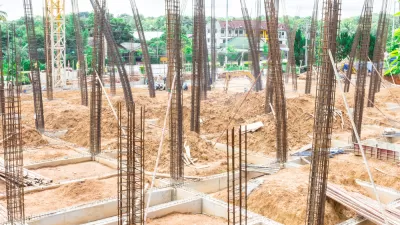Knee-jerk, ideological reactions to the California housing crisis rest on faulty arguments and threaten to cheat the state out of workable solutions.

Tony Roshan Samara's recent Salon piece attempts to absolve "left-leaning, anti-growth, NIMBY homeowners" of their role in the current housing crisis. But Samara's flimsy rationalizations are contradicted by a wealth of data, history, and scholarship—as well as plain common sense. Blinded by ideology, Samara merely repackages fundamentally flawed anti-housing positions that are superficially appealing, but which ultimately undermine affordability.
Samara's piece sets out from the puzzling notion that San Francisco's economic and moral imperative to build housing is negated by other municipalities' refusal to do so. This is like telling California to abandon efforts to cut greenhouse gas emissions because Wyoming isn't pulling its weight. But more importantly, it is demonstrably false that San Francisco "shoulders a disproportionate share of the housing burden" and "looks pretty good when compared with other jurisdictions."
From 2006 until at least 2011, San Francisco was, at the county level, the region's worst performer in terms of housing its worker population. The imbalance between jobs and housing has only worsened as San Francisco's employment continues to rise at rates that far outpace the provision of new housing. From 2010 to 2014, San Francisco added around 100,000 jobs. With only 8,290 housing units built during this same period, San Francisco came nowhere near meeting the needs of those new workers, let alone filling pre-existing deficits. In 2014, San Francisco's roughly 639,000 workers were duking it out over a mere 379,597 housing units. San Francisco's absolute and proportional rates of housing growth also remain well below both their historical highs and those of comparable high-tech cities, like Austin and Seattle.
Believing in separate "affordable" and "unaffordable" housing markets is fundamentally incompatible with concerns about displacement and gentrification. Displacement itself results from high-income households moving down market to find housing. Market-rate units therefore provide a crucial escape valve to relieve overall housing pressure. As they age, market-rate units can also very well become tomorrow's "affordable" housing. Samara insists that market-rate construction has no role to play in relieving the housing crisis, but he offers little to refute the "growing cross-ideological consensus" that growth restrictions push up housing prices and exacerbate economic segregation and inequality.
Samara illogically implies that building more housing creates an insurmountable demand for yet more affordable housing, ad infinitum. If this were true, cities with faster growth in market-rate units would have greater affordability problems, but this is not the case. Data show that markets with the fastest supply growth are among the least expensive, while the most expensive housing markets have some of the slowest supply growth. The issue is not that new market-rate housing in San Francisco generates an unusual number of low-paying jobs. Instead, the extraordinary cost of Bay Area housing overall means that an unusually large proportion of new workers are unable to find market-rate housing they can afford. Moreover, new construction is the primary mechanism by which San Francisco finances and creates new affordable units. By making it easier and quicker to build, housing costs could be brought down across the board, helping make market-rate housing affordable for a larger proportion of workers.
Samara also draws deceptive historical parallels and fundamentally mischaracterizes new development in the neighborhood known as the Mission. What is happening today could scarcely be more different from the government-orchestrated, wholesale demolition of low-income and minority neighborhoods that characterized San Francisco's shameful mid-century flirtation with urban renewal. Recent development in the Mission has instead taken place almost entirely on vacant or underutilized non-residential parcels. In its pre-election analysis of the now-defeated Mission housing moratorium, the San Francisco Controller's Office stated: "The 752–807 new housing units that would be affected by an 18-month moratorium would not require the potential demolition of any existing residential units." And contrary to Samara's assertions, San Francisco already has very strong rent-control and eviction protections that cover the majority of the city's multifamily housing. San Francisco should continue to strongly enforce its protections and educate tenants, but broadening or strengthening these laws is largely preempted at the state level by the Costa Hawkins Act.
It may come as a surprise, but tech firms are more victim than villain in the housing crisis. In truth, it is long-time residential land-owners who are capturing unearned value while externalizing the monetary and societal costs of the housing shortage. Indeed, Facebook's policy of offering employees a bonus to live closer to its corporate campus is wholly consistent with the sort of cost "internalization" Samara implied he supports. Finally, Google and Facebook want very much to build housing for their workers, but they are being thwarted by an unholy alliance of would-be progressives and well-to-do slow-growth activists.
Concerns about corporate power and economic injustice are well founded, but they can also be unwittingly abused. The need for more responsive public policy does not preclude the need for market-based solutions. The Bay Area and California need an "all of the above" approach to aggressively build new housing even as we seek higher-level policy reforms. Crafting good public policy requires us to look beyond the interpretations and approaches that flatter our ideologies, and be honest with ourselves about what works. Alleviating the housing crisis depends on it.
Eric Panzer is a UC Berkeley graduate with a background in environmental science and city planning, He works for Livable Berkeley, a non-profit whose mission is to promote great governance, environmental sustainability, economic vitality, and equity as the foundation of urban excellence.

Alabama: Trump Terminates Settlements for Black Communities Harmed By Raw Sewage
Trump deemed the landmark civil rights agreement “illegal DEI and environmental justice policy.”

Planetizen Federal Action Tracker
A weekly monitor of how Trump’s orders and actions are impacting planners and planning in America.

The 120 Year Old Tiny Home Villages That Sheltered San Francisco’s Earthquake Refugees
More than a century ago, San Francisco mobilized to house thousands of residents displaced by the 1906 earthquake. Could their strategy offer a model for the present?

In Both Crashes and Crime, Public Transportation is Far Safer than Driving
Contrary to popular assumptions, public transportation has far lower crash and crime rates than automobile travel. For safer communities, improve and encourage transit travel.

Report: Zoning Reforms Should Complement Nashville’s Ambitious Transit Plan
Without reform, restrictive zoning codes will limit the impact of the city’s planned transit expansion and could exclude some of the residents who depend on transit the most.

Judge Orders Release of Frozen IRA, IIJA Funding
The decision is a victory for environmental groups who charged that freezing funds for critical infrastructure and disaster response programs caused “real and irreparable harm” to communities.
Urban Design for Planners 1: Software Tools
This six-course series explores essential urban design concepts using open source software and equips planners with the tools they need to participate fully in the urban design process.
Planning for Universal Design
Learn the tools for implementing Universal Design in planning regulations.
Clanton & Associates, Inc.
Jessamine County Fiscal Court
Institute for Housing and Urban Development Studies (IHS)
City of Grandview
Harvard GSD Executive Education
Toledo-Lucas County Plan Commissions
Salt Lake City
NYU Wagner Graduate School of Public Service





























